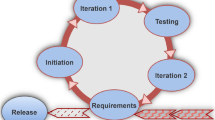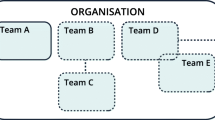Abstract
This paper reports on results from a long-term field study of globally distributed software development projects within a multinational organization. The research explores the issues involved in performing global software development, utilizing a perspective informed by CSCW research concerning the local organization of work practices and the key role of workers in being able to intervene in the ‘flow of work’ where necessary. The paper also raises some more general questions concerning the field of Global Software Development (GSD), in terms of the concepts and methods being used in the area. Our contribution is in the form of a CSCW-informed empirical study of the use of defect (or ‘bug’) tracking systems—systems which support the identification, classification and resolution of defects in the emerging software. In one case, the team persisted with a defect tracking system that they had used for years and maintained it in parallel with a system used by co-workers in other countries—all the while attempting to implement a bridge between the two. In the other, we report on how local software patches were created to allow for local work to proceed while not interfering with the existing coordination mechanisms between the local site and remote co-workers who were responsible for creating daily builds according to the overall project plan. In both cases, local practices were shaped by the necessity to keep work flowing across the whole project, even if this involved what might, at first sight, seem to go against project-wide practice. We discuss implications of these findings in terms of a key distinction between externally-prescribed ‘workflow’ and internally-managed ‘flow of work’ activities. We also explore how a heterogeneous ‘assembly’ of variably coupled systems may be the most appropriate image for technological support of distributed teams as they keep the work flowing in an orderly fashion. Overall, our work suggests that studies of global software development can profit from the CSCW tradition of workplace studies both conceptually and methodologically.







Similar content being viewed by others
References
Bannon, L., & Bødker, S. (1997). Constructing common information spaces. In Proceedings of the Fifth Conference on European Conference on Computer-Supported Cooperative Work (Lancaster, UK, September 07-11, 1997). J. A. Hughes, W. Prinz, T. Rodden, and K. Schmidt, Eds. ECSCW. Kluwer Academic Publishers, Norwell, MA, pp. 81–96.
Bannon, L., & Schmidt, K. (1991). CSCW: Four characters in search of a context. First European Conference on Consumer Supported Cooperative Work (ECSCW 89), Gatwick, London, ACM Press.
Boden, A., Nett, B., & Wulf, V. (2008). Articulation work in small-scale offshore software development projects. In Proceedings of the 2008 international Workshop on Cooperative and Human Aspects of Software Engineering (Leipzig, Germany, May 13–13, 2008). CHASE ’08. ACM, New York, NY, pp. 21–24.
Bødker, S., Kristensen, J. F., Nielsen, C., & Sperschneider, W. (2003). Technology for boundaries. In Proceedings of the 2003 international ACM SIGGROUP Conference on Supporting Group Work (Sanibel Island, Florida, USA, November 09–12, 2003). GROUP ’03. ACM, New York, NY, pp.311–320.
Bowers J., Button, G., & Sharrock, W. W. (1995). Workflow from within and without: technology and co-operative work on the print industry shopfloor. In Proceedings of ECCSW’95, Dordrecht. Kluwer Academic Publishers.
Bowker, G. C., & Star S. L. (1999). Sorting things out: classification and its consequences. MIT Press.
Button, G., & Sharrock, W. (1994). Occasioned practices in the work of software engineers. Chapter 9 in Requirements Engineering, Academic Press.
Button, G., & Sharrock, W. (1996). Project work: the organisation of collaborative design and development in software engineering. Computer Supported Cooperative Work, 5(4), 369–386.
Carmel, E., & Agarwal, R. (2001). Tactical approaches for alleviating distance in global software development. IEEE Software, 18(2), 22–29.
Casey, V., & Richardson, I. (2004). Practical experience of virtual team software development. EuroSPI 2004 Industrial Proceedings, Trondheim, Norway.
Damian, D., & Moitra, D. (2006). Guest editors introduction: global software development: how far have we come? IEEE Software, 23(5), 17–19.
de Souza, C. R. B., & Redmiles, D. F. (2008). An empirical study of software developers management of dependencies and changes, The 30th International Conference on Software Engineering (ICSE 2008, Leipzig, Germany), May, pp. 241–250.
Dittrich, Y., John, M., Singer, J., & Tessem, B. (2007). Editorial: for the special issue on qualitative software engineering research. Information and Software Technology, 49(6), 531–539.
Dourish, P. (2006). Implications for design. In R. Grinter, T. Rodden, P. Aoki, E. Cutrell, R. Jeffries, & G. Olson (Eds.), Proceedings of the SIGCHI Conference on Human Factors in Computing Systems (Montréal, Québec, Canada, April 22–27, 2006). CHI ’06. ACM, New York, NY, pp. 541–550.
Ebert, C., & Neve, P. D. (2001). Surviving global software development. IEEE Software, 18, 2.
Fraser, M., Stanton, D., Ng, K. H., Benford, S., O’Malley, C., Bowers, J., Taxén, et al. (2003). Assembling history: achieving coherent experiences with diverse technologies. ECSCW 2003: pp. 179–198.
Grinter, R. E. (1995). Using a configuration management tool to coordinate software development. In N. Comstock & C. Ellis (Eds.), Proceedings of Conference on Organizational Computing Systems (Milpitas, California, United States, August 13–16, 1995). COCS ’95. ACM, New York, NY, pp. 168–177.
Grinter, R. E. (1996). Supporting articulation work using software configuration management systems. Computer Supported Cooperative Work, 5(4), 447–465.
Grinter, R. E., Herbsleb, J. D., & Perry, D. E. (1999). The geography of coordination: dealing with distance in R&D work. In Proceedings of the international ACM SIGGROUP Conference on Supporting Group Work (Phoenix, Arizona, United States, November 14–17, GROUP ’99. ACM, New York, NY, pp. 306–315.
Hall, T., Ciolfi, L., Bannon, L., Fraser, M., Benford, S., Bowers, J., et al. (2001). The visitor as virtual archaeologist: explorations in mixed reality technology to enhance educational and social interaction in the museum. In Proceedings of the 2001 Conference on Virtual Reality, Archeology, and Cultural Heritage (Glyfada, Greece, November 28–30, 2001). VAST ’01. ACM, New York, NY, pp. 91–96.
Halverson, C. A., Ellis, J. B., Danis, C., & Kellogg, W. A. (2006). Designing task visualizations to support the coordination of work in software development. In Proceedings of the Computer Supported Cooperative Work Conference, ACM Press, pp. 39–48.
Heath, Christian C., & Paul Luff (1992): Collaboration and control: Crisis management and multi-media technology in London Underground control rooms. Computer Supported Cooperative Work (CSCW): An International Journal, vol. 1, no. 1–2, 1992, pp. 69–94.
Herbsleb, J. D. (2005). Beyond computer science, in International Conference on Software Engineering. 2005: St. Louis, Missouri, USA.
Herbsleb, J. D., & Moitra, D. (2001). Global software development. IEEE Software, 18(2), 16–20.
Herbsleb, J. D., Mockus A., Finholt, T. A., & Grinter, R. E. (2000). Distance, dependencies and delay, ACM conference on Computer supported cooperative work.
Hindmarsh, J., Heath, C., vom Lehn, D., & Cleverly, J. (2002). Creating assemblies:: aboard the Ghost Ship. In Proceedings of the 2002 ACM Conference on Computer Supported Cooperative Work (New Orleans, Louisiana, USA, November 16–20, 2002). CSCW ’02. ACM, New York, NY, pp. 156–165.
Holmström, H., Fitzgerald, B., Ågerfalk, P. J., & Conchúir, E. Ó. (2006). Agile practices reduce distance in global software development. IS Management, 23(3), 7–18.
Krishna, S., Sahay, S. et al. (2004). Managing cross cultural issues in global software outsourcing. Communications of the ACM.
Kuutti, K., & Bannon, L. (1996)). Remembering past, present and future—articulating dimensions of “organizational memory” for organizational learning. SIGOIS Bull, 17(3), 33–37.
Lee, C. P. (2005). Between chaos and routine: boundary negotiating artifacts in collaboration. In H. Gellersen, K. Schmidt, M. Beaudouin-Lafon, & W. Mackay (Eds.), Proceedings of the Ninth Conference on European Conference on Computer Supported Cooperative Work (Paris, France, September 18–22, 2005). ECSCW. Springer-Verlag New York, New York, NY, pp. 387–406.
Lethbridge, T. C., Singer, J., & Forward, A. (2003). How software engineers use documentation: the state of the practice. IEEE Software 20(6), 35–39.
Lutters, W. G., & Ackerman, M. S. (2002). Achieving safety: a field study of boundary objects in aircraft technical support. In Proceedings of the 2002 ACM Conference on Computer Supported Cooperative Work (New Orleans, Louisiana, USA, November 16–20, 2002). CSCW ’02. ACM, New York, NY, pp. 266–275.
Maraia V. (2005). Software configuration management best practices: defining a build, in build master, the: microsoft’s software configuration management best practices, Addison Wesley Professional, Nov 2005, retrieved at http://www.informit.com/articles/article.aspx?p=422304 [last accessed on 27 Aug.2008]
Martin, D., Bowers, J., & Wastell, D. G. (1997). The interactional affordances of technology: an ethnography of human-computer interaction in an ambulance control centre. In H. W. Thimbleby, B. O’Conaill, & P. Thomas (Eds.), Proceedings of HCI on People and Computers XII. Springer-Verlag, London, pp. 263–281.
Moitra, D. (2008). Leveraging global software development for competitiveness, Keynote at the International Conference on Global Software Engineering, Bangalore, India, Aug 2008.
Pettersson, M., Randall, D., & Helgeson, B. (2002). Ambiguities, awareness and economy: a study of emergency service work. In Proceedings of the 2002 ACM Conference on Computer Supported Cooperative Work (New Orleans, Louisiana, USA, November 16–20, 2002). CSCW ’02. ACM, New York, NY, pp.286–295.
Pollock, N. (2005). When is a work-around? conflict & negotiation in computer systems development. Science, Technology & Human Values, 30(4), 496–514.
Rönkkö, K., Dittrich, Y., & Randall, D. (2005). When plans do not work out: how plans are used in software development projects. Computer Supported Cooperative Work, 14(5), 433–468.
Sahay, S., Nicholson, B., et al. (2003). Global it outsourcing: management of software development projects. Cambridge University Press.
Singer, J., Lethbridge, T., Vinson, N., & Anquetil, N. (1997). An examination of software engineering work practices. In J. H. Johnson, (Ed.), Proceedings of the 1997 Conference of the Centre For Advanced Studies on Collaborative Research (Toronto, Ontario, Canada, November 10–13, 1997). IBM Centre for Advanced Studies Conference. IBM Press.
Suchman, L. A. (1987). Plans and situated actions: the problem of human-machine communication. Cambridge University Press.
Star, S. L., & J. R. Griesemer (1999). Reprint of Star and Griesemer 1989, “Institutional Ecology, ‘Translations,’ and Boundary Objects: Amateurs and Professionals in Berkeley’s Museum of Vertebrate Zoology, 1907–1939.” reprinted in Mario Biagioli (ed.), The Science Studies Reader, New York: Routledge, pp. 505–524.
Winberg, F., & Bowers, J. (2004). Assembling the senses: towards the design of cooperative interfaces for visually impaired users. CSCW 2004, pp. 332–341.
Acknowledgments
This work is part of the socGSD research project at the University of Limerick. socGSD is one of the Lero -the Irish Software Engineering Research Centre cluster projects funded under PI grant 03/IN3/1408C by Science Foundation Ireland (SFI). We wish to thank our informants in the observed company for allowing us to interview and live with them on site for many days.
Author information
Authors and Affiliations
Corresponding author
Rights and permissions
About this article
Cite this article
Avram, G., Bannon, L., Bowers, J. et al. Bridging, Patching and Keeping the Work Flowing: Defect Resolution in Distributed Software Development. Comput Supported Coop Work 18, 477 (2009). https://doi.org/10.1007/s10606-009-9099-6
Received:
Accepted:
Published:
DOI: https://doi.org/10.1007/s10606-009-9099-6




